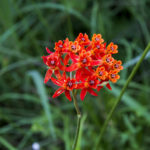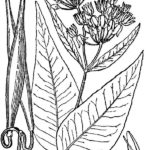Asclepias rubra
USDA, NRCS. 2018. The PLANTS Database (http://plants.usda.gov, 28 March 2018). National Plant Data Team, Greensboro, NC 27401-4901 USA.
Illustration: USDA-NRCS PLANTS Database / Britton, N.L., and A. Brown. 1913. An illustrated flora of the northern United States, Canada and the British Possessions. 3 vols. Charles Scribner’s Sons, New York. Vol. 3: 26.
What is Red Milkweed?
Other common spellings and names include: tall pink bog milkweed.
Physical Characteristics
Leaves:
- Opposite
- Immobile
- Egg or sword-shaped
- 2-6.3 inches long
- Up to 2.56 inches wide
- Dark green on top
Flowers:
- Many flowered
- Moderately large
- Dull red to purplish or lavender in color
Fruit:
- Dry
- Opens only on one side to release seeds when ripe
- Spindle-shaped
- 3.15-4.75 inches long
- About 0.59 inches thick
- Smooth
Seeds:
- Oval-shaped
- About 0.28 inches long
Stem:
- Slender
- 1.25-3.25 feet tall
- Simple
Where Does it Grow?
Red Milkweed is an obligate wetland plant for the Gulf Coast prairie and Great Plains regions and can be found in bogs, marshes, and meadows.
Bloom Color: Red , Pink , Purple
Bloom Time: May , Jun , Jul , Aug
Pros and Cons of Red Milkweed
Milkweed is the only plant eaten by Monarch butterfly caterpillars, one of the reasons their numbers are dropping is the loss of space for milkweed to grow due to mowing or pesticides.
Flowers are beneficial to native bees.
Submerged portions of all aquatic plants provide habitats for many micro and macro invertebrates. These invertebrates in turn are used as food by fish and other wildlife species (e.g. amphibians, reptiles, ducks, etc.). After aquatic plants die, their decomposition by bacteria and fungi provides food (called “detritus”) for many aquatic invertebrates.



